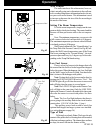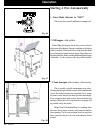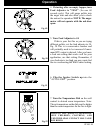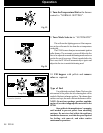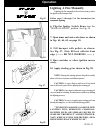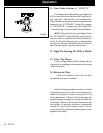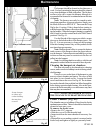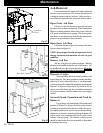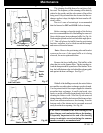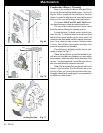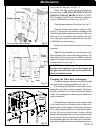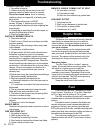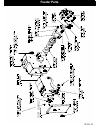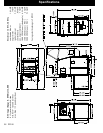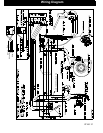
31PF100
Cleaning the accordion heat exchanger/firebox:
Before starting to clean the inside of the firebox
area it is recomended that all of the baffling be removed.
Start with the upper heat exchanger baffle. See Fig. 66.
Push straight upward on the lower ash slide angle aprox.
1/2”. This will release the baffle from the positioning
brackets and allow it to be tilted toward the burnpot
and removed from the furnace.
Note: Observe the positioning tabs and bracket
system on the rear of the upper baffle as it is being
removed, for easier replacement later.
Remove the lower baffle plate. This baffle is a flat
plate that sits on the furnace floor. Tip the top edge to-
ward the burnpot and lift up and out of the furnace. Note
how the baffle bottom edge sits behind the ash pan guide
and against the heat exchanger. See Fig. 67.
With all of the baffling removed, the entire firebox
area and the accordion heat exchanger can be cleaned.
Use the pointed end of the scraper supplied to clean the
accordion heat exchanger. A small wisp brush, wire
brush, or an old stiff bristled paint brush works best for
cleaning the firebox walls. All of the fly ash removed
during cleaning will fall to the bottom of the furnace where
there is an unobstructed access for cleaning. Even the
bottom ends of the chains can be seen and accessed
easily from the door opening. See Fig. 68.
Fig. 66
Fig. 67
Fig. 68
Ash slide angle
Upper Baffle
Lower
Baffle
Plate
Ash Pan Guide
Shaker Chain Ends
This cleaning should be done after each ton of pel-
lets used. The frequency of this cleaning will be directly
related to the quality and the ash content of the pellets
being used. Keep in mind that the cleaner the heat ex-
changer surface is kept, the higher the heat transfer effi-
ciency will be.
Due to it’s ease of restarting it is recommended
that the furnace be OFF and COOL before cleaning.
CAUTION: Cleanout of the heat exchanger, flue
pipe, chimney, and combustion blower fan housing,
is especially important at the end of the heating
season to minimize corrosion during the summer
months, caused by accumulated ash.
Maintenance



